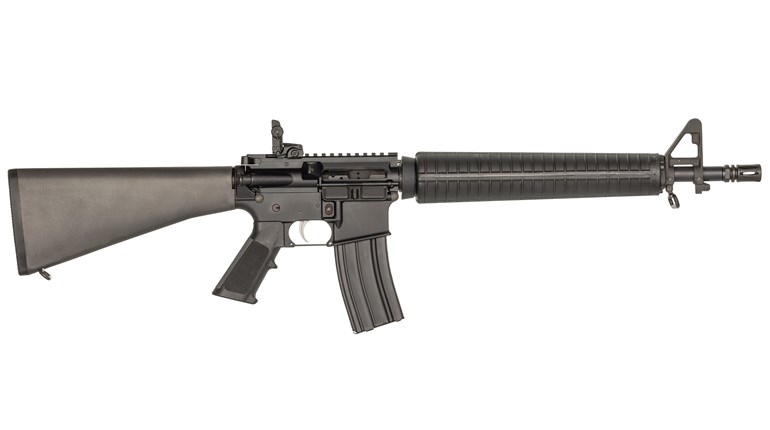
Dead Foot Arms is a veteran-owned firearms accessory company in Wisconsin that makes a unique AR-15 side-folding stock adapter that allows AR owners to fire their rifles with the stock folded for as long as they like. The Modified Cycling System is built on a modified bolt carrier group and buffer tube system that dramatically shortens the required stock length of the AR-15 platform, while still providing enough energy to the bolt carrier group to allow for sustained rapid fire when needed. The innovative cycling system allows the stock of the rifle to be folded over, decreasing the overall length of the AR, making it much handier to move in and around confined spaces.
The Modified Cycling System consists of buffer tube, stock adaptor, recoil spring and bolt-carrier group for your caliber of choice. The system is available right now in either .223 Rem./5.56 NATO/.300 Blackout or 9mm and is also offered in versions that fold the stock to the left or the right. The Modified Cycling System requires a compatible bolt-carrier group, so if you prefer to use your own BCG with the system, you’ll need to send it into Deadfoot Arms and have them machine it to work with the folding stock buffer tube and spring.
Speaking of buffer tubes, the Modified Cycling System does not come with a buttstock or arm brace. However, almost any brace or stock that works on a mil-spec tube will work with the Modified Cycling System. My testing was done with my home-defense .300 Blackout pistol, and the KAK Industry Shockwave brace I had been using on that pistol before adding the folding stock worked great after I made the change.
Installing the Modified Cycling System on your AR-15 is easy for anyone who’s changed out the stock on an standard AR-15 lower, and requires no special tools beyond an AR-15 armorer’s wrench. One change from a stock AR-15 is that the bolt-carrier group of the Modified Cycling System doesn’t pop out of the upper as in a stock AR-15 setup. Instead, the buffer tube is swung to the folded position, and the bolt-carrier group pops out of the back of the lower once it is released by turning a knurled knob on back of the system.
The big question is, when modifying the tried and true inner working mechanism of the AR-15, is what those modifications do the reliability of your gun, and I’m pleased to report that there no hiccups at all during my reliability testing of the Modified Cycling System. In order to ensure that success, however, I installed an adjustable gas block on rifle and tuned the gas system to work well with the Dead Foot Arms system.
Installing an adjustable gas block and adjust the gas volume passed to the operating system is something I do anytime I upgrade or modify the operating system of an otherwise stock AR-15, so this modification was not out of the ordinary for me. To test the reliability of the Deadfoot Arms Modified Cycling System, I shot 260 rounds of SIG Sauer 120-grain supersonic .300 Blackout and 220-grain subsonic ammo, and then swapped out the .300 Blackout upper for a .223 Rem. upper and fired an additional 100 rounds of 5.56 NATO M193 55-grain ammo through my pistol. The gun ate up and spat out every round, with no issues feeding or cycling during all 360 rounds, no matter if the stock was folded or not.
One thing that did pop up during testing is that shooting supersonic .300 Blackout rounds with the shorter recoil spring on the Modified Cycling System snapped the trigger on my AR-15 into my trigger finger with enough vigor to make shooting more than 100 rounds at a time a painful affair, but the lower-recoiling subsonic .300 Blackout rounds were much easier on my trigger finger.
I attached a laser sight to my pistol prior to my range session, and that brought out a big advantage to this system: With the stock folded and the gun in held in awkward angles outside of my normal shooting stance, I was able to place rapid, aimed shots on targets out to 20 yards using the dot as my aiming point rather than the sights on the pistol, and shooting the gun while holding it at odd angles did not affect the reliability of the Dead Foot system in any way. Navigating around my house with my empty AR pistol in my hands highlighted the advantage of laser/folding-stock AR pistol, and the gun was easier to maneuver in tight spaces than if I were using a conventional buffer tube and brace.
If you’re looking to make your AR-15 a little easier to use in the tight confines of a vehicle or inside a building, give the Dead Foot Arms Modified Cycling System a look. I found it to be a reliable and useful addition to my home-defense AR pistol, and it makes a great gun even better.



































